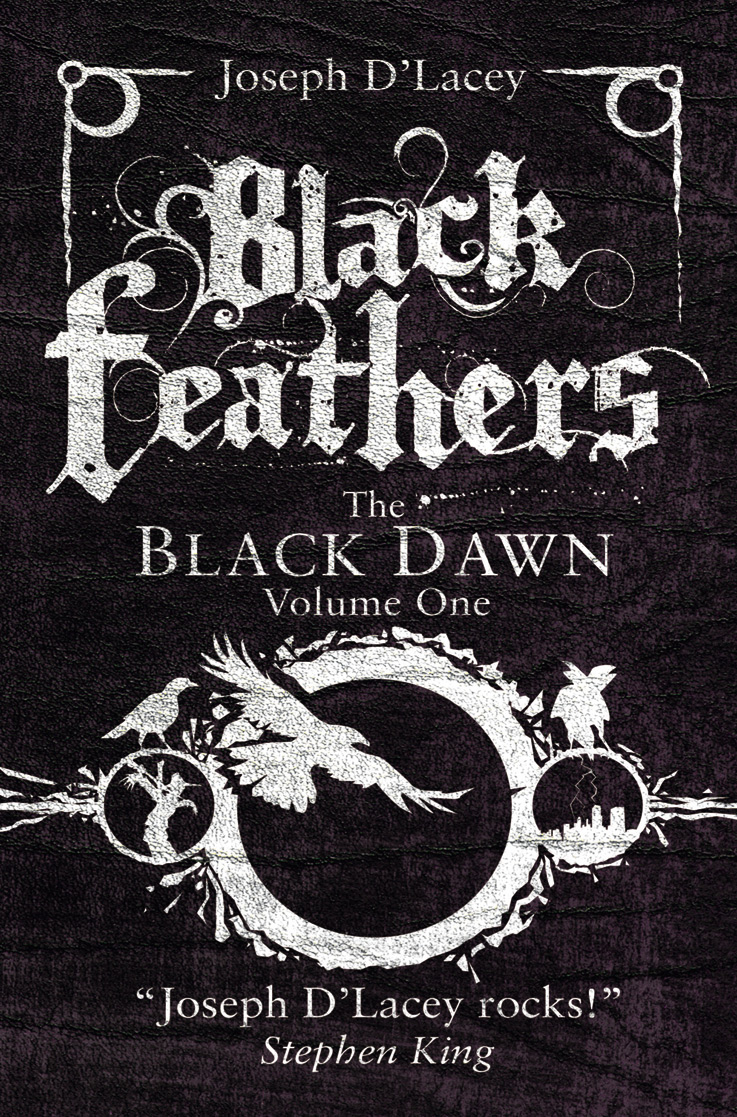In the early 21st Century, the world is crumbling. The economy is failing, the world is ravaged by storms, and people speak of a mythic figure named the Crowman, (aka Black Jack or the Scarecrow), who haunts peoples’ visions and dreams. Some see him as a Satan-like figure, some as savior, while many see this figure as the harbinger of the Black Dawn, the apocalypse that will transform the Earth. Gordon Black is born at the turn of the century just as the apocalyptic slide begins. As a baby, corvids are drawn to wherever Gordon is and as the boy grows, he begins collecting the fallen black feathers from the birds. Throughout Black Feathers, the strongest thing I felt D’Lacey was trying to convey in this dark, apocalyptic tale through his characters is that hope is ever-present.
As the economy collapses, people (including the Black family) begin hoarding food and supplies, something against the law of the totalitarian state, enforced by the Ward. When the Ward seizes the Black family, Gordon is wandering the fields near his house with his sister, allowing him to avoid capture. Gordon plays a cat and mouse game with the Ward, eluding their efforts to seize him as he meets good, hopeful, and helpful people across the broken landscape of England as well as people who are not so kind-hearted. The Ward, as it turns out, knows more about Gordon than Gordon knows about himself. The one thing giving Gordon hope, driving him, is the message from his mother that he must find the Crowman. Gordon is a teenager when the world begins to crumble; he doubts himself, he’s scared, but the belief his mother sparks in him drives him, and because of those well-balanced strengths and weaknesses of Gordon as a human character, I believed in him.
In the broken, post-apocalyptic world of Gordon’s future, Megan Maurice is a curious young girl who comes to apprentice under Mr. Keeper (this is both a title and his name). A Keeper’s position is on the same level as a priest or respected person of knowledge. Here, Megan is apprenticing with Mr. Keeper to learn and spread the story of the Crowman. Again, the theme of hope is present in Megan’s story. She undergoes some dark trials throughout Black Feathers, but Mr. Keeper continually stresses to Megan that she is to trust him. Whenever her trials become difficult, Mr. Keeper’s words resound in her memory, her trust in him grows.
D’Lacey has written and published mostly in the Horror states of the SFF country, and Black Feathers has a healthy helping of horror tinged through its narrative. The Gordon Black storyline, in particular, has a similar feel to some of Gaiman’s darker novels and stories, particularly the similarity individual members of the Ward featured—Skelton and Pike—bear with Messrs. Croup and Vandemar from Neverwhere. Although a Stephen King blurb/quote is used on the front cover of the novel I found more in common with Robert McCammon’s giant apocalyptic novel Swan Song than in King’s post-apocalyptic opus The Stand.
What I find somewhat unique—and interesting—about the story D’Lacey is telling is the dual narrative of the apocalypse as it happens paralleling the post-apocalyptic. More often than not, post-apocalyptic stories feature society rebuilding after an apocalyptic event, while sometimes these stories focus on the quick ramp-up and the immediate response of civilization to the apocalyptic event. In Black Feathers D’Lacey’s dual narrative opens the window on both time frames, and slowly reveals the connection between the two. I found the novel to be extremely addictive, a novel I didn’t want to put down, finishing it barely two days after starting to read it.
Furthermore, a lot of the imagery has a haunting beauty. From the opening of Chapter 6:
Down at the river the October sun lets the water break its smile into a million pieces of gold, each so brilliant they left a mote of light inside the eye, each one unique and momentary.
I only have two minor quibbles about this novel, one of which is that it truly is only the first part of a story. While I understand Black Feathers is the first of a duology, I was expecting slightly more closure and not the sense that an epic novel was halved. Megan’s story has a neat bow put upon it, while Gordon’s did not have that sense of closure. The second quibble is the sometimes unsmooth transition between Megan’s narrative and Gordon’s narrative. However the incompleteness of the novel has me more excited to dig into the second part of the story, The Book of the Crowman, as soon as it publishes.
Black Feathers is an exceptional piece of apocalyptic/horror/fantasy fiction. D’Lacey finds a perfect balance between the familiar and a way of telling it in a fresh, engaging, and compulsively readable fashion. Bring on The Book of the Crowman!
Black Feathers is published by Angry Robot. It is available April 2.
Rob Bedford lives in NJ with his wife and dog. He reviews books and moderates forums at SFFWorld, runs a blog about ‘stuff’ and has been known to get very scruffy-faced between April and June.










